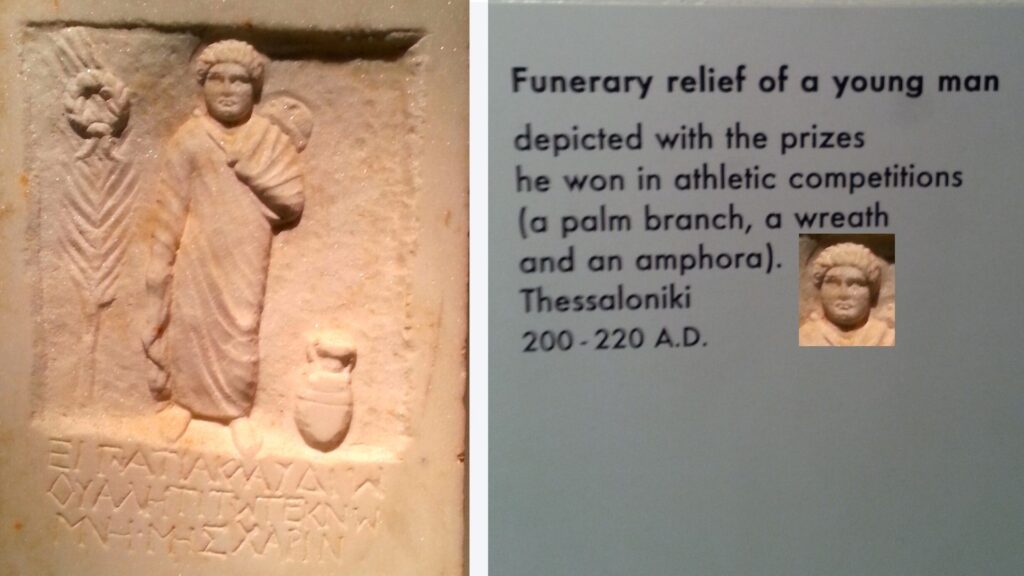At the Archeological Museum of Thessaloniki, we see the gold decoration of a diadem. The diadem is an athletic symbol (not a religious symbol like the wreath.) The diadem was a woolen ribbon. The gold decoration (the decoration of the diadem) is not the diadem itself.
Look at the golden decoration which has survived.

The word diadem comes from a verb (διαδένω) which means “I tied around.” The diadem was a ribbon, which was wrapped around the head. The ribbon was decorated with gold. Made of woolen ribbon, the diadem itself, has not survived through time.

The thing that I would like to point out is the crafting technique, the technique of granulation. The Greeks had a way of making spheres, like the head of a needle, all of the same size, and with the spheres they made the design on the jewel.

The diadem was used in two ways.
In the first use of the diadem, a red or blue woolen ribbon was tied around the head of the winner at the very moment when he was proclaimed to be a winner. It was kept tied around his head until the last day of the games. On the last day of the games the winner proceeded to the front of the temple with his diadems (because possibly he was multi winner.) Thrusting his arms wide and holding a branch of bough, the winner proceeded, officially, ceremonially, as in a processional, to the front of the temple where he received his wreath. The wreath was the actual prize.
So, the diadem, was the symbol of the winner from the first moment when he was claimed a winner, until the last day of the games.

Special personalities, like the kings of Macedonia, also participated in the inter-Greek games. These special people used to decorate their ribbons with gold, ivory, and special symbols to show that they were something different from the others. Their diadem was also tied around the head (not a freestanding jewel on their head. It was not like the wreath, freestanding upon the head. Their diadem was tied around the head. A diadem was an athletic symbol.
In history, we gradually added the meaning of “head jewel” when we say diadem. But the word diadem has never lost its athletic significance.
The second use of the diadem, exceptionally, exceptionally, the diadem, the ribbon, was not only used in athletics. It was also used in the time of monarchy, the time when royalty was still functioning with a queen. Queens among the Greek states never reigned. When the King died, the closest male successor became the next King (usually the king’s oldest son), and the Queen automatically became Queen Mother. But the Queen did not have the right to put the crown on her head. The Crown was only for the King, only Kings reigned. A Queen was the escort of the King.
Whenever the King was presented in an official presentation, either as a High Priest or political figure, the Queen escorted him. They were both well dressed, and she decorated her head with a ribbon, an incredibly special ribbon, the ribbon of the Queen. Her hair was dressed in a special way and tied around her head was the ribbon, the diadem of the Queen.
Now let us learn more about the diadems in the Bible.
Diadem, in the Bible, is mentioned only in one book, the book of Revelation. In the book of Revelation, three figures use the diadem. One is the dragon; another is the beast. The third is the Word of God coming from the heavens. For the dragon and the beast, one has 10 diadems and the other has seven diadems, representing ten and seven victories. But the third, the Word of God coming from the heavens, has countless diadems, countless symbols of victory.
The book of Revelation speaks of the symbols of victory, and the diadem, many diadems. (If your Bible translation depicts crowns, crowns are not a good translation. It does not make sense to depict Jesus with crowns, like hats piled on the head, one upon the other.) Picture in your mind the diadem of the athletic victories, the ribbons. Jesus, the Word of God coming from the heavens, has countless diadems.
Revelation 19:11-13
”And I saw heaven opened, and behold, a white horse, and He who sat on it is called Faithful and True, and in righteousness He judges and wages war. 12 His eyes are a flame of fire, and on His head are many diadems (many symbols of victory;) and He has a name written on Him which no one knows except Himself. 13 He is clothed with a robe dipped in blood, and His name is called The Word of God.”
Diadems are the symbols of victory.











